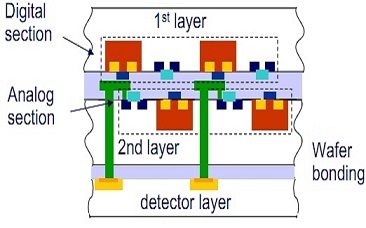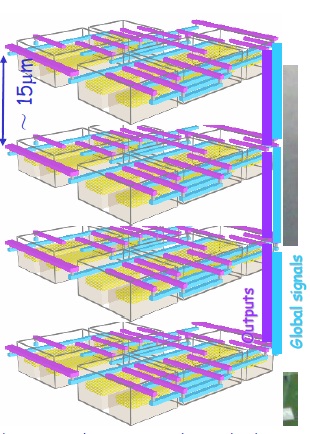.
Design of a Monolithic Momentum Detector using a 3D IC Vertical Integration Approach
In
this summary we present a novel approach to
particle detection and track reconstruction
for HEP (High Energy Physics) vertex
experiments based on 3D
IC pixel detectors.
Our approach is based on the superposition
of several monolithic detectors including
both sensing area and control/signal
elaboration circuitry, integrated in a 3D
stack by means of intra-silicon
vertical connections.
Each layer consists in a
fully functional sensor derived from already
fabricated and tested 2D CMOS Active Pixel
vertex detectors, manufactured using a commercial
sub-micron CMOS VLSI technology.
|
|
|
|
|
|
|
|
|
Such
layers could be thinned down and then
stacked in a monolithic device through
silicon vias (TSV) connections. Such a
detector configuration has been extensively simulated
by means of physical prediction tools
(Sentaurus, GEANT4), and
a first prototype (featuring two superposed
tiers with a front-to-front coupling) has
been designed using a 130nm CMOS technology,
containing a 5000 square microns sensitive
area and several test structures, as well as
an ad-hoc developed standard cell set; it is
currently under production and first
prototypes will be available at mid-2010.
A
more complete prototype, featuring a 7
square millimeters sensitive area and the
possibility of a higher number of stacked
tiers has been designed and will be
submitted during 2010. Negligible
multiple scattering effects are
expected to happen in such a structure
(since incoming particles have to cross only
12 microns of bulk silicon and about 10
microns of silicon oxide) with respect to
bump-bonded non-monolithic sensor stacks
conventionally used for track
reconstruction, where incoming particles
have to cross several millimeters of
material, thus increasing the scattering risk.
According to simulation results, the
information coming from the thinned,
spatially close stacked layers could be
usefully exploited to extend the detection
capability of the monolithic sensor,
achieving a spatial resolution of the
crossing point in the micrometer range. Also
according to simulation results, such a
structure could be used to achieve an
accurate estimation of the particle
incidence angle, with angular precision
down to the tens of milliradian range,
depending on the number of superposed tiers
and on the impact point/tilt of the incoming
particle.
Cite as
A. Marras et al., “Design of a Monolithic Momentum Detector using a 3D IC Vertical Integration Approach” presented to the conference “Vertically Integrated Pixel Sensors (VIPS), Pavia (Italy). April 22-24, 2010”.5


Leave a comment